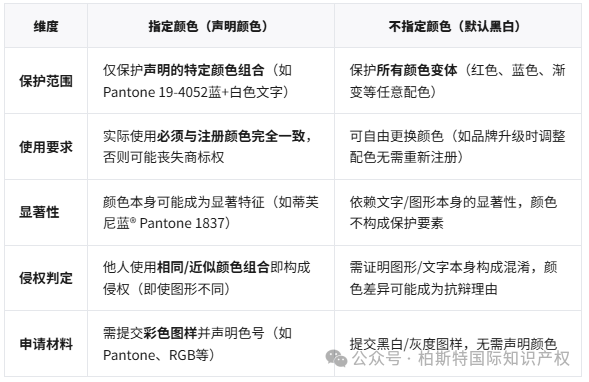What is the difference between specifying a color and not specifying a color in US trademark registration? How to describe color code/color scheme?
The core difference between specifying a color (Color Claim) and not specifying a color
2、 Specification for color code description when specifying colors
When declaring colors, they need to be included in the applicationAccurately describe the color schemeAnd comply with USPTO technical standards:
1. Color code system selection
Preferred Pantone:USPTO recommends the use of Pantone Matching System (PMS), please specifyPantone Number(such as Pantone 185 C)
ExampleColor Statement: The trademark consists of red (Pantone 185 C) and white (uncolored area), with the text in red and the background-alternative:
RGB values (limited to electronic display trademarks, such as R255 G0 B0)
CMYK values (for printing purposes)
Universal color name (such as "gold", but may require additional Pantone number due to vague description)
2. Describe the logical requirements
Position correspondence: Clearly identify the trademark elements corresponding to each color (such as text, borders, graphic parts)
ExampleThe letter 'NOVA' uses Pantone 2945 C (dark blue), and the circular frame uses Pantone 1235 C (gold).
Proportion explanation (optional): If the color proportion is a prominent feature, it should be indicated (such as "Blue accounts for 60% of the trademark area, red accounts for 40%")
3. Document submission requirements
Pattern format: Color JPG/PDF must be submitted, and the color must match the declared color number
Color code annotation: Color codes can be annotated at the edges of the drawing (not mandatory, but it is recommended to add them to improve the approval rate)
1. Proof of Color Significance
If trademark protection is obtained through color (such as Tiffany Blue), it is necessary to prove that the color has obtained a "secondary meaning" through use, that is, consumers directly associate the color with the brand.
Evidence materials: sales data, advertising investment, market research reports, etc.
2. Irreversibility of color declaration
Once the designated color is registered,
Cannot be changed to unspecified color
If you need to expand the scope of protection, you need to submit a new application.
3. Common reasons for rejection
Blurred color code: such as only stating "blue" without providing Pantone number
Color Conflict: The declared color combination lacks distinctiveness (such as red and yellow used in the fast food industry)
Pattern mismatch: There is a significant color difference between the submitted color pattern and the described color code
4、 Strategic recommendations
Prioritize not specifying colors: Unless the color is a core brand asset (such as Coca Cola Red, UPS Brown), default black and white registration is used to retain maximum freedom of use.
1. Register a black and white trademark first to cover all color variants
2. Add designated color registration to color schemes that have been successfully validated in the market
Globalization considerations: Pantone is an internationally recognized standard. If planning to expand overseas, avoid using regional color code systems (such as DIC in Japan)





